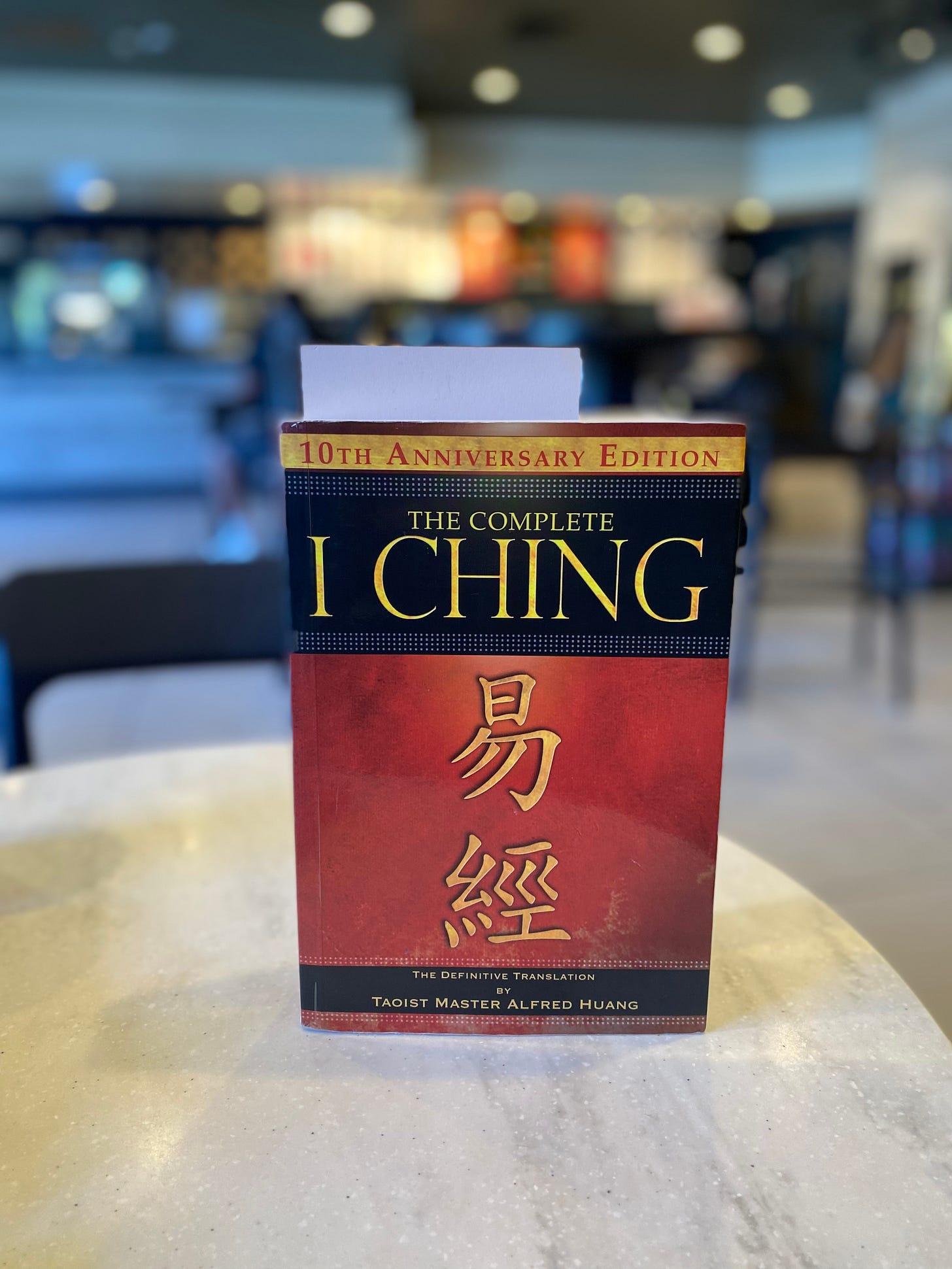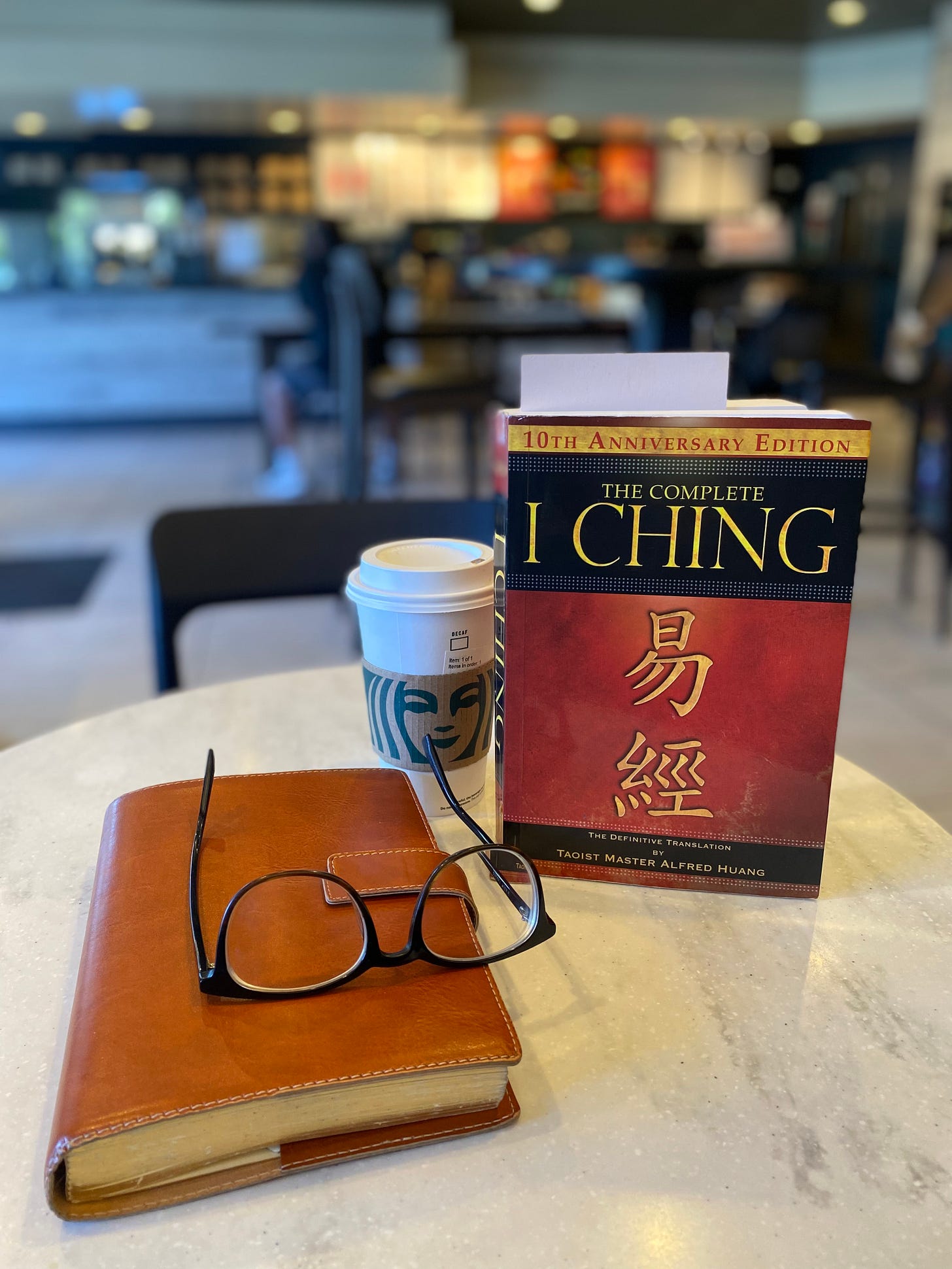I first learned about this book in the mid-nineties. A friend of mine spoke glowingly about it to me while at a conference in Washington D.C. Having experienced family and religious abuse while as a youth, she found the words of this book illuminating and full of prescient wisdom.
Known as the I Ching or “The Book of Changes,” it is one of the oldest and most revered texts in Chinese literature and philosophy. Its history dates back over two thousand years, and it has played a significant role in Chinese culture, philosophy, and divination.
I recently picked up a copy of "The Complete I Ching" by Taoist Master Alfred Huang while on a trip to Phoenix. Unlike other translations, I’ve found it to be quite useful in helping me wade through the complexity of the wisdom it offers.
The paradoxical mystery of life has always been a source of deep fascination to me. As a Taoist, I am captured by the random nature of existence and how we as humans go about navigating it. Ultimately, I believe our peace comes from our ability to flow with life’s ebbs and flows. This as opposed trying to force life to conform to our peculiar notion of how we think it should be.
The ancient origins of the I Ching can be traced back to ancient China, possibly as early as the Western Zhou period (1046–771 BCE). It is said to have been compiled and edited by King Wen of Zhou and his son, the Duke of Zhou.
King Wen is traditionally credited with creating the foundational hexagrams and texts of the I Ching. He is said to have composed the initial 64 hexagrams, each consisting of six lines, through meditative reflection on the patterns of the natural world.
In my reading I was fascinated to learn that Confucius, the great Chinese philosopher and Sage, provided one of the earliest commentaries on the I Ching. He emphasized its use as a moral and ethical guide and believed it held profound wisdom about human nature and conduct.
Over the centuries, various scholars and philosophers have added commentaries and interpretations to the I Ching, further expanding its depth and complexity. The most famous of these commentaries is the "Ten Wings," traditionally attributed to Confucius and his disciples.
Numerous translations of the I Ching into Western languages have made it more accessible to a global audience. Well-known translations include those by Richard Wilhelm and Carl Jung.
A broader cannon of Taoist philosophy, particularly the ideas of Laozi and Zhuangzi, has also informed the interpretation of the I-Ching. This was seen as a reflection of the Tao, the fundamental principle underlying the universe.
The I Ching, however, may be best known as a popular tool for divination during the Han Dynasty (206 BCE–220 CE). During that historical period, people used yarrow stalks or coins to generate hexagrams and seek guidance on personal matters, decisions, and events. Today, it has gained popularity in the West as a tool for personal growth, decision-making, and spiritual exploration.
Divination is the practice of seeking guidance or insight into the future or one's personal circumstances through various methods. In the case of the I Ching, divination involves the following steps:
Hexagram Generation: The I Ching consists of 64 hexagrams, each composed of six lines. To cast a hexagram, a diviner traditionally used 50 yarrow stalks or three coins. Modern interpretations often use three coins as well.
Casting: The diviner tosses the coins or yarrow stalks and records the results, typically as heads (H) and tails (T). Each coin toss represents one line of the hexagram.
Line Interpretation: The lines are then arranged from bottom to top, creating a hexagram. Each line has a specific meaning, often related to yin (broken line) or yang (solid line) symbolism. These lines are interpreted individually.
Changing Lines: Sometimes, lines may change from yin to yang or vice versa. These changing lines are considered particularly significant and are also interpreted.
Hexagram Interpretation: The diviner consults the text of the I Ching associated with the hexagram and changing lines. This text provides advice, insights, and wisdom relevant to the question or situation posed by the diviner.
Reflection: The diviner reflects on the hexagram's message and applies it to their question or concern. The guidance provided by the I Ching is often philosophical and can be open to interpretation.
Repeat as Necessary: Some diviners may cast multiple hexagrams to gain further insights or clarification on the matter at hand.
It's essential to note that the I Ching is not a fortune-telling tool in the traditional sense. Instead, it is considered a means of obtaining guidance and wisdom for decision-making and self-reflection. Many people use it as a tool for personal growth, seeking insights into their lives, relationships, and challenges.
Its primary appeal to me is in its ability to provide thoughtful and often profound perspectives on the complexities of life and the human condition. It is valued for its rich symbolism, philosophical depth, and the open-ended nature of its interpretations, allowing individuals to apply its teachings to their unique circumstances.
Today, the I Ching remains a revered and influential text in both Chinese and global culture. It is valued not only for its divinatory aspects but also for its profound philosophical and ethical teachings, making it a timeless source of wisdom and insight.
" The Complete I Ching" by Taoist Master Alfred Huang” is a comprehensive guide to the ancient Chinese divination system known as the I Ching, or the Book of Changes. It offers a detailed exploration of the I Ching's philosophy, history, and practical application.
Huang’s book begins with an introduction to the I Ching's origins and its significance in Chinese culture and philosophy. It then provides a thorough explanation of the hexagrams and trigrams that form the basis of the I Ching, along with their symbolism and interpretations.
The core of the book lies in its divination methods, where readers can learn how to cast and interpret hexagrams to gain insights into various life situations. Master Huang emphasizes the ethical and spiritual aspects of using the I Ching as a tool for self-discovery and personal growth. He also discusses how to use the I Ching for meditation and contemplation.
When reading the I Ching, it is best to approach it with an open mind, using it as a tool for contemplation rather than relying on it solely for decisions. Its interpretations are subjective and open to individual interpretation.
"The Complete I Ching" is widely praised for its accessibility and depth of knowledge. Master Huang's translation is considered one of the most accurate and readable versions available, making it suitable for both beginners and experienced practitioners. As is the case with many readers, I appreciate the book's emphasis on the ethical and spiritual dimensions of the I Ching, which sets it apart from many other interpretations.
Overall, this book can serve as a valuable resource for anyone interested in exploring the I Ching's wisdom and using it as a tool for guidance and self-reflection. Its combination of historical context, translation accuracy, and practical advice makes it a highly respected work in the field of Chinese divination and philosophy.
An Invitation From Diamond-Michael Scott
The Chocolate Taoist is a reader-supported publication. To receive new posts and support my book publishing journey, please consider becoming a member supporter at $6.00/month or $60.00/year.







Wow. Was first introduced to I Ching in the late 60s - all the rage at my college. Brought back some good memories. Now inspired to reconnect. Thank you!